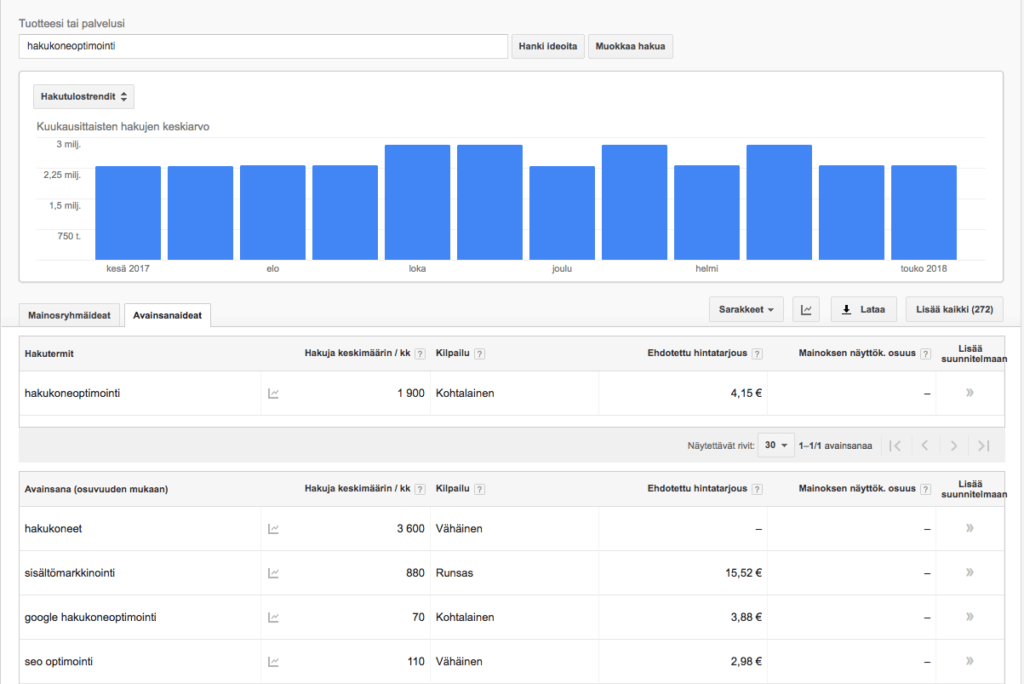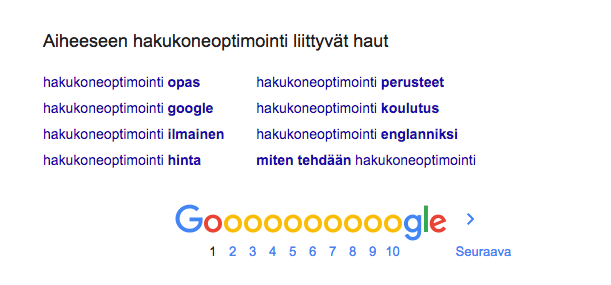Search Engine Optimization (SEO), also known as Google optimization, is one of the most cost-effective marketing methods. This is because the visibility achieved through SEO does not require any payments to Google. In Finland, there are 30 million Google searches made every month, so it is possible to generate a significant amount of traffic to a company's website through search engines - and doing it yourself is free.
This guide covers extensively the things required for good search engine visibility.
Search Engine Optimization - Basics
What is Search Engine Optimization?
Search Engine Optimization (SEO) is a technique used to influence a website's visibility in search engine results. It should not be confused with Google advertising (Google Ads), which is paid advertising through Google. Paid Google advertising can be identified by the "Ad" label next to the search result.
SEO affects natural, or organic, search results. These are the search results below Google ads, which do not have an advertising label. SEO is accomplished by modifying the website's structure, content, and source code.
Why is it important?
According to HubSpot, 81% of people conduct online research before making significant purchasing decisions. Through SEO, a company can make its website visible to these information seekers. After conducting background research, the buyer compares the best options and then makes a decision, or a purchase.
By creating high-quality content related to your company's products or services, you can become a part of this decision-making process and increase your sales.
How is SEO done?
SEO is accomplished through internal and external optimization. Internal optimization's purpose is to inform Google about the purpose of the website. Simply producing text aimed at human readers is not enough; the same story must also be told to Google's spiders. These spiders are programs that crawl and archive all web pages worldwide. After a spider's visit, a fresh webpage finds its way into Google's search results - if its content is deemed relevant by the spiders for a user using a specific search term. These spiders also visit your company's website, so your site's purpose must be communicated in a way that machines understand.
External optimization, which occurs after internal optimization, involves strengthening a website's authority in Google's eyes. This is done by acquiring links from other websites to your own. Google's idea is that the more links a site gets from other sites, the more credible it is. A link is a kind of endorsement for the content of the site it points to.
SEO Technique
Internal optimization and external optimization are the most important aspects of SEO. However, before performing these, keyword analysis must be done to determine the keywords for which SEO will be performed.
Let's now delve into keyword analysis.
Optimization Begins with Keyword Analysis
The purpose of keyword analysis is to identify the keywords for which optimization will be performed. It is advisable to optimize one page with one primary keyword. The chosen keyword should have the highest traffic and the best search intent.
Interpreting the searcher's intent is one part of keyword analysis. For example, the search term "search engine optimization" has a very broad search intent - the search can be performed to increase general knowledge, for learning the basics, or for finding a company that offers search engine optimization services. This is the most common search term used to explore the subject.
The longer the keyword, the further along the searcher usually is in doing background research - and the clearer the searcher's intent.
Google's Keyword Planner is a free tool that allows you to explore keywords and search volumes. You can find the Keyword Planner in the AdWords dashboard under Tools -> Keyword Planner -> Find new keywords using a phrase, website, or category. In the "Your product or service" field, enter the keyword you want more information about. Searching for the term "search engine optimization" brings up a page similar to the image below.

Google shows the search volumes for the queried keyword and also suggests new keywords. With my example search, Google found a total of 272 keyword suggestions. It is advisable to download these suggestions as a CSV file using the "Download" button in the image. Examining and filtering the data is easier with Excel.
Keyword research should also be done directly through Google's search engine. By typing "search engine optimization" and scrolling to the bottom of the page, you will find a field similar to the image below. Google provides additional suggestions for new keywords here. You can pick suitable keywords from these and search for new suggestions through the AdWords Keyword Planner.

Internal Optimization
In internal optimization, the creation of sufficiently extensive textual content is crucial. Keywords should also appear in the right places within the text. Let's go through the aspects related to internal website optimization.
Title and Meta Description
The title is the most important place for a keyword. The keyword must absolutely be found within this HTML tag. The recommended length for a title is 60 characters - anything beyond this will be truncated from Google's search results page.

The meta description is a brief description of the page that appears below the title on the search results page. It is not a direct ranking factor (meaning it does not directly impact a page's ranking in search engines), but it does affect the click-through rate (CTR), which is likely a ranking factor. CTR refers to the percentage of people who see the search results page and click on your page's result. For example, if one out of a hundred people clicks on your link, the CTR is 1%. The more attractive the text is, the better CTR the search result will achieve. It's important to note that the attractiveness of the title also affects the click-through rate.
Headings
The website's heading structure must be semantically correct. There should only be one H1-level heading. After that, there are H2, H3, and H4-level headings. The required depth depends on the breadth of the topic. The H1 heading of this article is "Search Engine Optimization (SEO) - A Guide to Google Optimization". After this, I have divided the text into three main sections using H2 headings. The main sections are:
"What, why, and how" - basics of search engine optimization
"The technique of search engine optimization" - a deeper guide on the technique
"Modern search engine optimization is comprehensive marketing" - conclusion of the guide
Below these, I have further divided the text into H3 and H4-level headings.
Body Text
Insufficient text content is the most common mistake in search engine optimization. There should be as much text as possible, preferably over 1000 words. Product descriptions in online stores often have a harder time generating content, so a smaller amount may suffice. There should be enough keywords in the text. Additionally, their use should be varied with different synonyms, inflections, and related keywords. In other words, the topic should be covered in as many different ways as possible.
The text should be structurally lightweight. The attention span of an online user is very limited, so pages are often scanned rather than read thoroughly. Short paragraphs and the use of lists help create a lightweight structure.
The use of bold and italicized keywords is a minor ranking factor, so this can be used strategically in appropriate situations.
Images
Keywords should be chosen as the names of images being used for optimization. Additionally, the alt-tag of the image should contain the optimized keyword. Google's spiders do not interpret images properly, so this tag is intended for them. The alt-tag informs the spiders about the content of the image.
Schema Entries
Schema entries are structured data that provide Google with more detailed information about the content and purpose of a website. With Schema, a company can provide more detailed information about itself in the knowledge panel on the right side of the search results page. This is a significant advantage, as the knowledge panel takes up a large portion of the search results page, making it easily noticeable to people. Additionally, the use of Schema entries is a ranking factor, meaning that using Schema helps in improving search rankings.
Through Schema, an e-commerce store can display star ratings and product prices in its search results. This has a strong impact on CTR (Click-Through Rate) - who wouldn't prefer to click on a search result with attractive orange stars and the price directly visible?
In addition to price and product ratings, Schema entries can provide Google with information such as the company's address, phone number, and opening hours. The information is placed in the website's source code using a special JSON-LD script. The accuracy of the Schema can be verified with Google's testing tool.
External Optimization
External optimization separates the wheat from the chaff. The purpose of this phase is to acquire links from other websites pointing to your website. Acquiring links is a crucial part of search engine optimization, but it is often overlooked. For many, this is also the most challenging part of optimization, as it requires imagination and a significant amount of time to find suitable websites.
Links can be divided into two categories: dofollow and nofollow links. Dofollow links are the ones that a search engine optimizer is particularly interested in. Why? Because these links pass link juice to the pages they point to.
Spiders interpret web pages in HTML language. So, to them, a link appears as follows: <a href="https://www...">Anchor Text</a>. The link may also have the addition of rel="nofollow", which tells the spiders that this link does not need to be followed. Links containing the nofollow tag do not pass link juice, so they do not provide direct benefits in search engine optimization. However, they must also be present, as a link profile consisting solely of dofollow links is unnatural.
Anchor text is the text visible at the clickable part of the link. Placing the optimized keyword as the anchor text helps in improving search engine rankings. So, next time you publish a link on a website, use a more descriptive text as the anchor text instead of "click here" - this way, you get the most out of the link.
However, keep in mind that the same link text should not be used too frequently, as Google considers this unnatural and may lead to penalties.
Site Structure
The technical implementation of a website also affects its visibility in search engines. Let's take a look at the technical implementation of a website and how it impacts the rankings in Google.
Information Architecture, Internal Linking, and Link Structure
One common issue for larger e-commerce sites is indexing of pages - there are so many subpages that Google's spiders don't visit all of them frequently enough. Therefore, the information architecture of a website should be as 'shallow' as possible. This means that every page should be accessible with as few clicks as possible. The three-click rule is often mentioned - meaning that even the furthest corner of a site should be reachable with three clicks.
The link juice obtained through external optimization is distributed within the site according to the internal link structure - the more internal links lead to a specific page, the more of the link juice it receives, and the better it performs in Google search results. It's advisable to adjust the internal link structure so that the most important pages receive the most links.
It's important for page URLs to be user-friendly. www.example.com/keyword is the best URL structure for an optimized page. URLs containing numbers and random characters do not provide any information about the page's content to the reader or to Google.
SSL Connection
A website with an SSL-secured connection can be identified by the https prefix in the domain and the padlock icon that appears in the address bar. An SSL connection is an important feature for modern websites, as it enhances the site's security. It is also a ranking factor, so implementing it also helps in search engine optimization.
Mobile-Friendliness
About half of website users are mobile users, so responsive websites are an absolute requirement for modern businesses. Mobile-friendly sites also help in improving search engine rankings, similar to SSL connections. This is very logical, as Google wants to display pages in its search results that provide a good user experience and have high security.
Site Speed
Site speed affects search engine rankings both directly and indirectly. The direct impact occurs when a site is too slow - Google reduces the visibility of such sites as a penalty for poor user experience. The indirect impact occurs when a dissatisfied visitor leaves the site after a few seconds of loading and clicks on another search result through Google - this is a signal to Google of poor content and/or user experience, which in turn affects the site's search engine ranking.
Measurement and Tracking
Like any other marketing efforts, search engine optimization needs to be measured and tracked. This can be done best by using Google Analytics to track visitor data and registering the site in Google's Search Console tool.
Through Analytics, you can easily monitor the development of visitor numbers over time. Among other things, Analytics provides information on the total traffic to the site, traffic sources, and factors indicating the quality of the site, such as the bounce rate and average time spent on a page. Consistently growing organic traffic is a clear sign of successful search engine optimization.
Google Search Console serves as the communicator between the search engine optimizer and Google. Here, you can see the links pointing to your site, different keywords visitors have used to find your website, the times when Google's spiders visited different pages, and more. A wealth of different information can be obtained.
I also recommend using a paid tracking tool like Semrush, Ahrefs, or Moz for those who want to invest in search engine optimization seriously. Through these tools, you can monitor the progress of your website's search engine optimization measures in real-time. Additionally, these tools can be used in external optimization to search for links.
Modern Search Engine Optimization is Comprehensive Marketing
Just ten years ago, search engine optimization was very straightforward - you had to cram keywords as many times as possible in as many places as possible. However, modern search engine optimization is much more comprehensive, combining high-quality content creation with visibility acquisition from other websites. Google has also evolved over the years, and keyword stuffing like this no longer works.
Having good search engine visibility alone is not enough; the content must also be of high quality so that visitors coming to the site through search engines are ready to buy the company's products or services. A positive impression is created with impressive and functional websites, whose textual content reinforces the image of the company's expertise. These elements help establish trust with visitors, which is a prerequisite for building customer relationships.
Links acquired through external optimization also help improve the company's online visibility. A good way to acquire links is by creating expert articles for other websites (guest posts) and joining various industry associations. These efforts not only increase visibility and traffic through search engines but also through other websites.
Google's user base and search volumes are growing year by year. Still, only a few companies utilize search engine optimization as part of their marketing strategy. According to a study conducted by the Finnish Business Association a couple of years ago, only 11% of digitally-oriented companies use search engine optimization as a marketing tool. The percentage is even lower when considering all types of companies. I have also observed this in my practical work - the competition for many keywords is still very weak.



